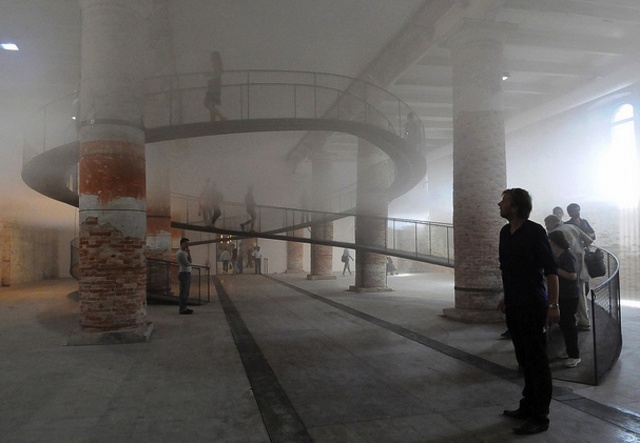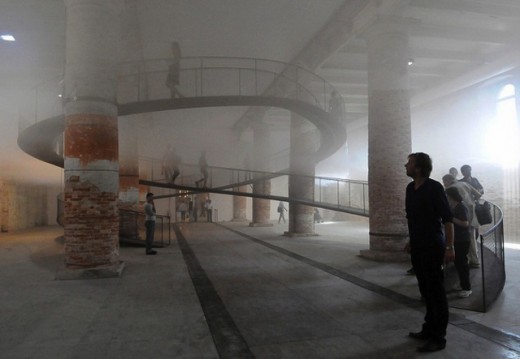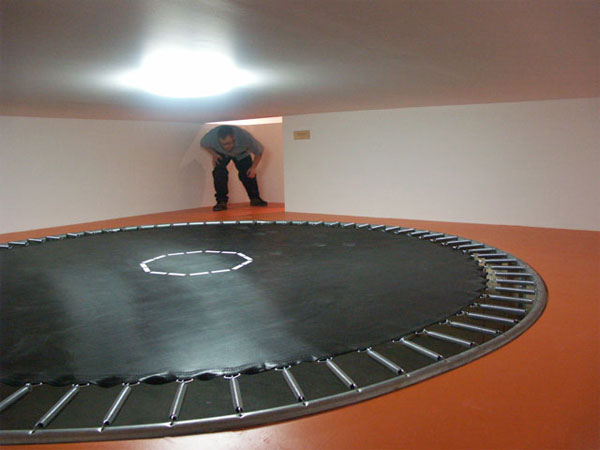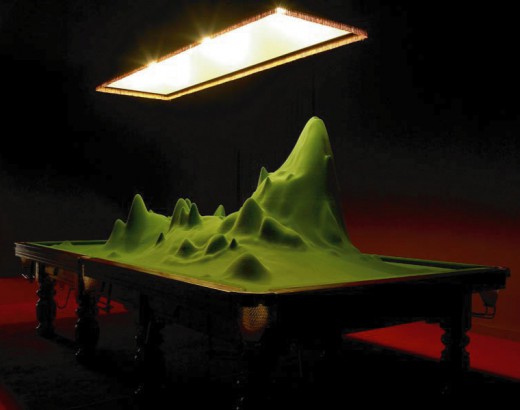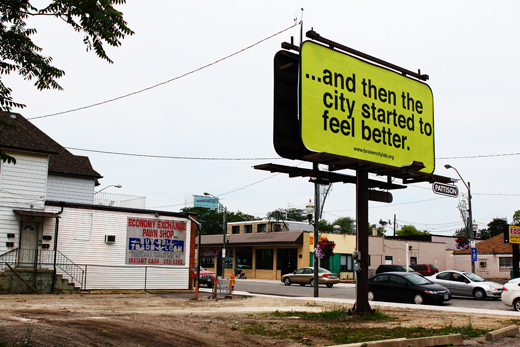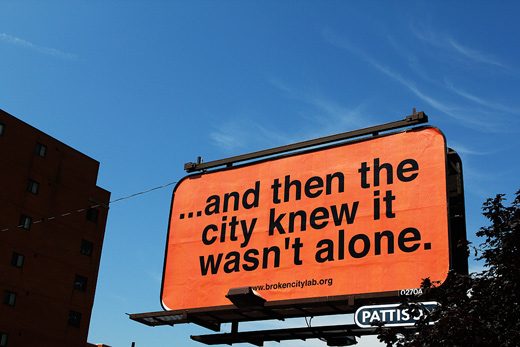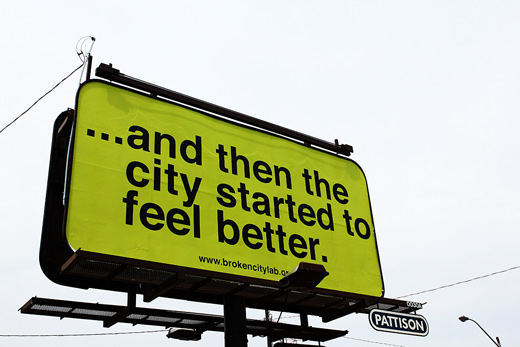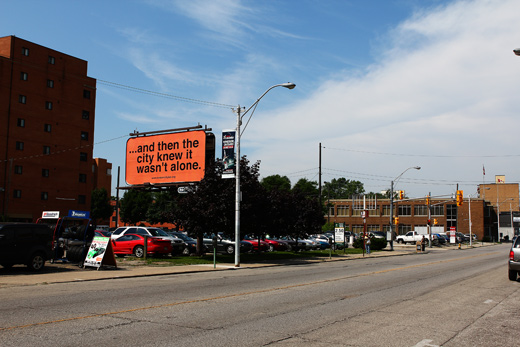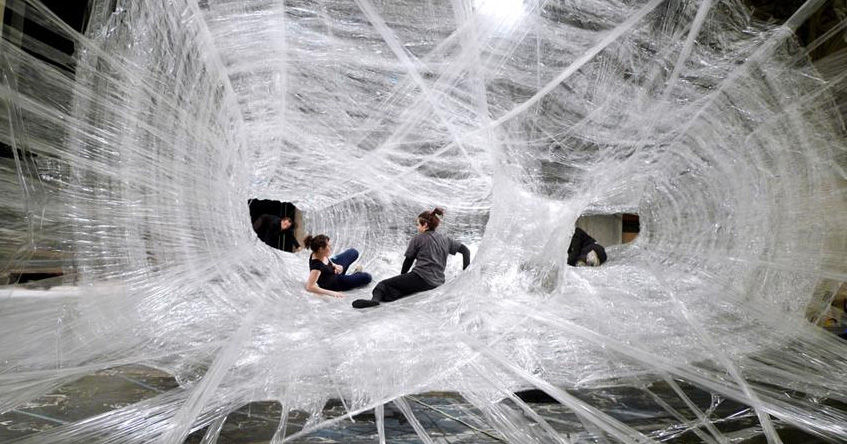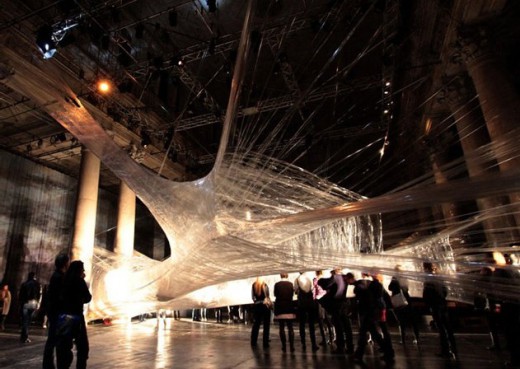Tetsuo Kondo Architects teamed up with a German climate engineering firm called Transsolar to create this, an indoor atmosphere complete with clouds. They managed this feat by pumping three layers of air into the room: “cool dry air at the bottom that keeps the cloud floating, hot humid air in the middle to fashion a dense fog and hot dry air at the top.” The project’s creators also decided to include a circular ramp so visitors can walk through the clouds above them. This reminds me of Damien Hirst‘s claim that someday he would find a way to create an indoor rainbow in a gallery (I’m not sure he’s been able to pull it off yet). Either way, it’s pretty amazing how much this indoor atmosphere changes the room’s perceived size.
Casino Luxembourg: This is Not a Casino
I recently came across some documentation of a visual arts exhibit at Casino Luxembourg called, in English, “This is Not a Casino.” The show features a plethora of sculptural and installation work that seemingly plays games with the viewer/participant.
For instance, the above image is a pool table that could never be used as such. Also included in the exhibit are a trampoline with no room for a person to jump and a basketball net with an almost endless veil of a net attached to the rim.
I really enjoy work like this, work that mocks those who think that art exhibits should be superficially gratifying and easy to digest.
…and then the city…
Though we’re still very much in the middle of thinking about, beginning to write about, and generally talk about all of the amazing things that we learned as part of Save the City, these billboards are the last part of the project to be launched.
These two statements are among the many, many, many that we came up with after thinking through the experiences that we had and the people that we got to meet with Save the City, and maybe in particular, our final event, How to Save a City.
I think we wanted to suggest the end of one part of a conversation and the beginning of another. In terms of our own research, I think we’re ready to start looking at problems in different ways, as a kind of continuum of ideas, rather than points from which to react.
So, you can see these billboards in Windsor. The first, “…and then the city knew it wasn’t alone.” is at University and Church, visible when traveling west.
And the second, “…and then the city started to feel better.” is at Wyandotte and Parent, visible when traveling west.
More ahead, and in the meantime, SRSI.
Broken City Lab: Save the City is generously supported by the Ontario Arts Council.

Numen/For Use’s Tape Installation
Ever wonder what 530 rolls of self-adhesive tape would look like if you used it to create a spiderweb? It would probably look much like Numen/For Use‘s Tape Installation in Odeon, Vienna. While I always appreciate projects that are so ambitious and visually stunning, I’m growing wary of excessive waste. Clear packing tape is, for the most part, not recyclable (due to its adhesive) and using 530 rolls for a temporary project is a bit tough for me to grasp.
While I don’t mean to sound like a worrier, I’m just concerned about projects that are so overwhelming to the viewer that he or she can’t stop for a minute to think about the implications of production. We (BCL) have used plastic products in some of our projects in the past, but questions about waste were usually addressed. The most I can hope for is that artists keep asking these important questions when they decide to take refined materials and transform them.
There are a couple of images of this massive installation after the jump.
Streetlight Storm by Katie Paterson
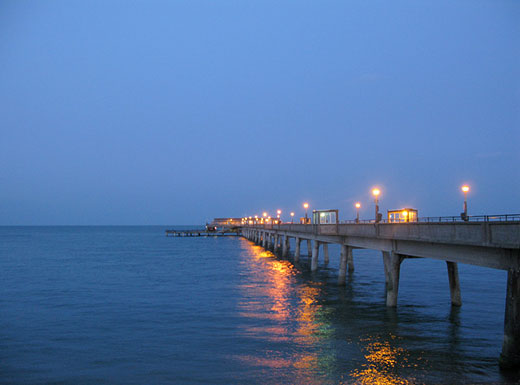
At any one time there are around 6000 lightning storms happening across the world, amounting to some 16 million storms each year. Such dizzying statistics are useful to hold in mind while experiencing Streetlight Storm, a new artwork by Katie Paterson.
Paterson’s work often deals with the translation of experiences of nature to representations of nature. I quite enjoy projects like this that visualize the complexities of data from the natural world in quiet, simple ways, as previously noted.
httpv://www.youtube.com/watch?v=MfsqlBrqlSs
Be warned, the music kind of destroys this video. At any rate, for one month on Deal Pier in Kent, during the hours of darkness, the pier lamps will flicker in time with lightning strikes happening live in different parts of the world.
[via PSFK]
David Rokeby’s long wave
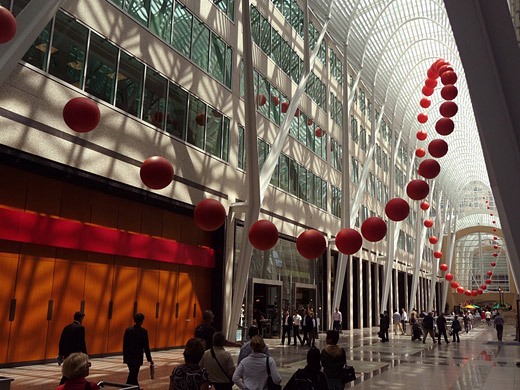
David Rokeby is a Canadian artist who worked for years in new media, creating interactive installations, and exhibiting them around the world (including here in Windsor most recently at the 2008 Media City -curated AGW exhibition). I had the opportunity to work with him on that 2008 show, Plotting Against Time, and he is one of the nicest and most brilliant people I’ve ever met.
More recently, his work has turned to large-scale installations. 2007’s Cloud played with perception through small sculptural elements rotating under a computer’s control.
This year’s long wave is a site specific installation that was commissioned by Luminato, Toronto Festival of Arts + Creativity and was on view at the Allen Lambert Galleria, Brookfield Place, Toronto, June 5 – 20, 2009. It is a 380 foot long, 60 foot high sculpture tracing a helix through the entire length of the galleria.
“long wave” is a materialization of a radio wave, a normally invisible, but constantly present feature of environment. It represents the length of a radio wave in the short-wave radio band, in between the sizes of AM and FM radio waves. In our contemporary wireless environment, populated by tiny centimeter long wifi transmissions, these radio waves are really the dinosaurs of our communications era.
I’m getting more and more interested in larger-scale installations like this that at least in part respond to the architecture in which they are situated. With so many vacant building across this city, why worry about a sculpture garden when we could have an “installations in abandoned factories” tour?
Mobile Mobile: Upcycled Phones Make Music
To cut a long story short, after a company-wide upgrade the agency had a lot of old mobiles gathering dust. Lost Boys International took these, built and hoisted a gigantic interactive chandelier/mobile that plays christmas jingles in their reception area.
When no one interacts with the sculpture, it plays “Carol of the Bells”. But you can also play with it. You can control it through this website or you can send a tweet with #lbitree and it will react to it.
Given some upcoming projects that we’re going to be tackling are going to be a bit more technology intensive, and in one instance is actually going to use cell phones (though not in this capacity), I thought I’d post it to add to the research archives. What’s really great is that LBI creative director, James Theophane, offers a quick breakdown of how the installation works, well worth a read to get an idea of some of the magic behind the installation. Also interesting is the Ning project site that was used by the folks making the installation as it happened in real-time.
[via today and tomorrow]
FREE by Sean Martindale
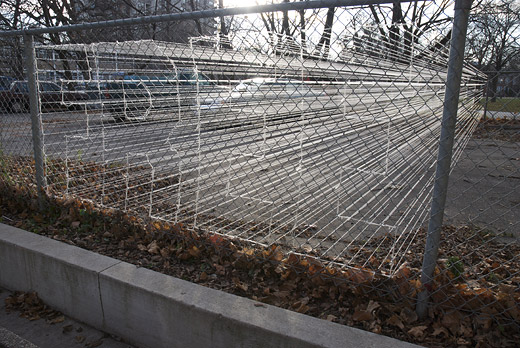
21,633 feet of salvaged nylon string was strung between the two parallel fences over a 24-hour period to spell out FREE in a fenced-off parking lot for the AGO.
We’ve written about Sean Martindale’s green sleeves in the past, and with this project, I really liked how the string stretched across the lot and connected the two sides. I just wish the entire lot had been done.
[via Torontoist & Wooster Collective]
Spencer Finch: The River That Flows Both Ways
httpv://www.youtube.com/watch?v=OIjV5yBxbLc&feature=player_embedded
Inspired by the Hudson River, The River That Flows Both Ways is a project by Spencer Finch that documents a 700-minute (11 hours, 40 minutes) journey on the river in a single day.
On June 12, 2008, from a tugboat drifting on Manhattan’s west side and past the High Line, Finch photographed the river’s surface once every minute. The color of each pane of glass was based on a single pixel point in each photograph and arranged chronologically in the tunnel’s existing steel mullions. Time is translated into a grid, reading from left to right and top to bottom, capturing the varied reflective and translucent conditions of the water’s surface.
Much of Finch’s work relies on scientific, or at least methodological process, to re-present natural occurrences or phenomenon. I really enjoy the processes involved in his work and his continuing translation of information and data, or at times, the failure thereof.
Mariele Neudecker’s Over and Over, Again and Again
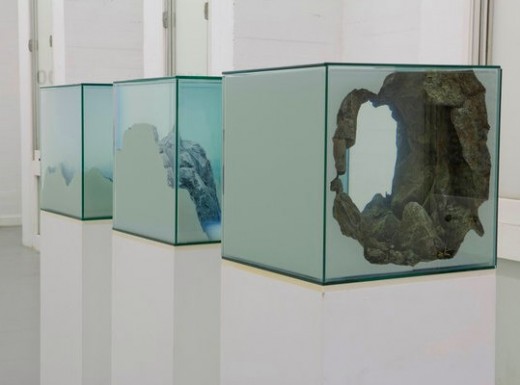
Out of Mariele Neudecker‘s impressive body of work, her piece “Over and Over, Again and Again” hit me the most. This particular work is made from salt, water, and fiberglass and functions as a window into a small landscape. All three tanks line up to create an additive image. Besides being an optical masterpiece, this work is small but expansive simultaneously. I find it tough not to appreciate this level of technical mastery. Wouldn’t it be interesting to create a mini Windsor-in-a-cube?
Continue reading “Mariele Neudecker’s Over and Over, Again and Again”
